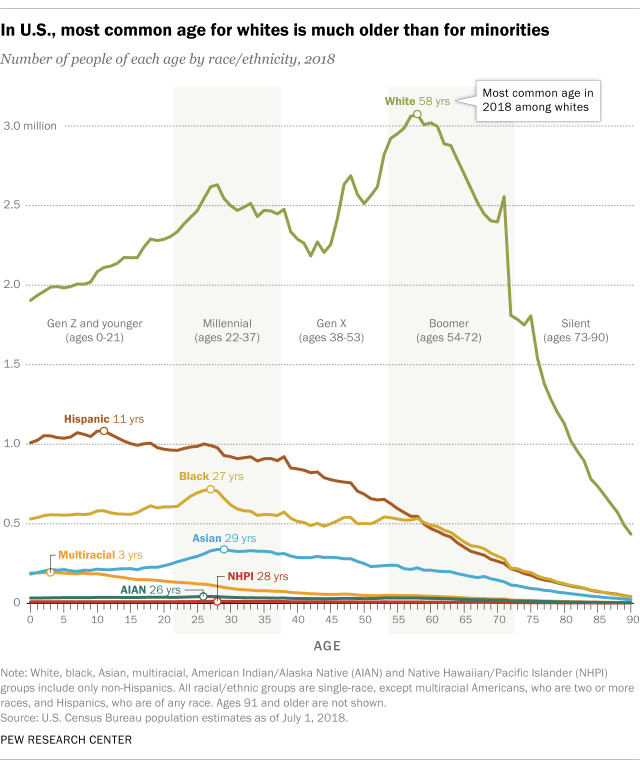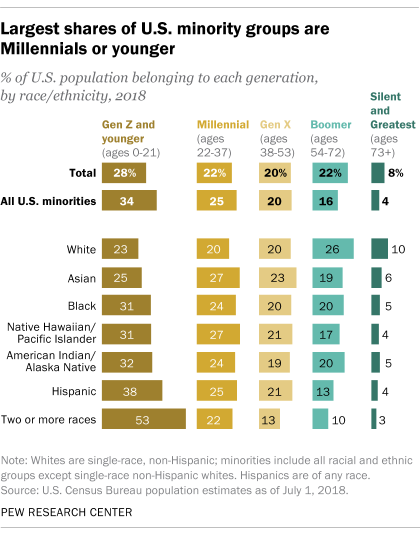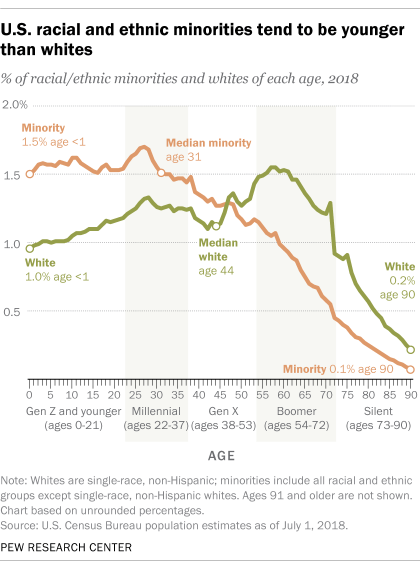There were more 27-year-olds in the United States than people of any other age in 2018. But for white Americans, the most common age was 58, according to a Pew Research Center analysis of Census Bureau data.
In the histogram above, which shows the total number of Americans of each age last year, non-Hispanic whites tend to skew toward the older end of the spectrum (more to the right), while racial and ethnic minority groups – who include everyone except single-race non-Hispanic whites – skew younger (more to the left).
The most common age was 11 for Hispanics, 27 for blacks and 29 for Asians as of last July, the latest estimates available. Americans of two or more races were by far the youngest racial or ethnic group in the Census Bureau data, with a most common age of just 3 years old. Among all racial and ethnic minorities, the most common age was 27.
One reason non-Hispanic whites are disproportionately older than other Americans is that they were the biggest population gainers from the post-World War II baby boom – an era before many of today’s minority immigrants entered the country. Whites were the only racial or ethnic group in which Baby Boomers made up a larger share than Millennials in 2018 (26% vs. 20%).
By comparison, nearly six-in-ten minority Americans were Millennials or Generation Z and younger. (Generation Z begins with those born in 1997, but the Center has not set an official endpoint.)
Non-Hispanic whites constituted a majority (60%) of the U.S. population in 2018, and they were also the oldest of any racial or ethnic group as measured by median age – a different statistic than most common age (mode). Whites had a median age of 44, meaning that if you lined up all whites in the U.S. from youngest to oldest, the person in the middle would be 44 years old. This compares with a median age of just 31 for minorities and 38 for the U.S. population overall.
Racial and ethnic minorities made up 40% of the U.S. population last year, an estimated increase of about 1,271,000 people from 2017. The minority population’s growth stands in contrast to the non-Hispanic white population, which declined by about 257,000 between 2017 and 2018.
Americans of two or more races were the youngest racial or ethnic group in the Census Bureau data as measured by median age (21 last year). Multiracial Americans were also the only group where roughly half (53%) belonged to a single generational group – Gen Z and younger. Hispanics under the age of 22 were the second-largest such group but still only represented 38% of all U.S. Hispanics.
U.S. Hispanics were also a notably youthful group, with a median age of 30. As a separate Pew Research Center report noted, Latinos have long been one of the nation’s youngest racial or ethnic groups, dating back to at least 1980. Today, the relative youth of Hispanics is driven by the U.S.-born Latino population, nearly three-quarters of whom were Millennials or younger.
Asians were older than most other racial or ethnic groups last year, though not as old as whites. Their median age was 37. The highest shares of Asians are Millennials (27%) and Gen Z and younger (25%).
The median age of black Americans was 34 last year. More than half of blacks were Millennials (24%) and Gen Z and younger (31%), while 20% were Gen Xers and another 20% were Boomers.
Minorities’ higher growth rate is expected to continue, and the minority population will likely surpass whites in the next several decades. As of 2015, most Americans under the age of 5 were racial and ethnic minorities, though only by a small margin.
Note: This is an update of a post originally published on July 7, 2016, and written by George Gao, a former associate digital producer.



